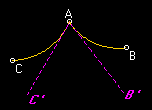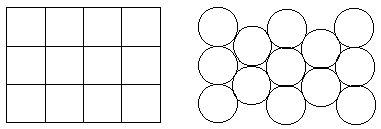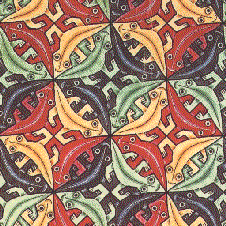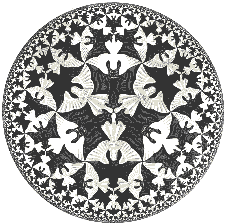
9: Activities - How to get started Exploring
Table of Contents:
9-1:
Example Activity - Adjacent Angles
NonEuclid is a simulation that allows you to draw lines and circles
in the Hyperbolic Plane.
Many of the items in the "Help" menu present a set of statements that
are theorems in Euclidean Geometry. Your job is to determine which of the
statements are also theorems in Hyperbolic Geometry.
For example, the following statement is a theorem in Euclidean Geometry:
Euclidean Theorem:
The adjacent angles formed by a pair of intersecting lines are supplementary,
and together measure 180°.
In order to determine if this statement is a theorem in Hyperbolic Geometry
you should attempt to construct a counter example - an example where the
sum DOES NOT equal 180°.
To do this, first construct three or four random pairs of intersecting
lines. Next, plot a point at the intersection of each pair of lines. There
are two different ways you can plot the intersection points. The inaccurate
way is to select the "Plot Point" command, move the mouse to the
point where the lines cross, and click. This method is inaccurate because
it is unlikely that you will succeed in getting the mouse exactly on the
intersection point. The accurate method is to select the "Plot Intersection
Point" command from the "Constructions" menu. Either way, once
you have plotted the intersection point, then use the "Measure Angle"
command from the "Measurements" menu to measure the two angles in
each pair of adjacent angles.
If you succeed in constructing a counter example, then you have proved
the Euclidean Theorem about adjacent angles false in Hyperbolic Geometry.
Failing to construct a counter example does not prove anything; however,
if, after many tries, you fail to construct a counter example, then the
statement is likely to be true in Hyperbolic Geometry. .
Note: be aware of rounding. When
the "Measure Angle" command reports that an angle is 45.5° it might
actually be 45.4817331°.
9-2:
Activity - Angles
 WHAT
IS A HYPERBOLIC ANGLE:
WHAT
IS A HYPERBOLIC ANGLE:
Hyperbolic Angles are formed by the intersection of Hyperbolic rays
analogous to the formation of angles in Euclidean Geometry. The measure
of a Hyperbolic angle, ÐBAC is defined
to be the measure of the Euclidean angle, ÐB'AC',
formed by the Euclidean tangent lines, AB' and AC'.
MEASURING AN ANGLE IN NONEUCLID:
You can measure a Hyperbolic angle by selecting the "Measure Angle"
option from the "
Measurement" Menu.
ACTIVITY: The following is
a list of theorems about intersecting lines in Euclidean Geometry.
Which (if any) are true in Hyperbolic Geometry?
-
The adjacent angles formed by a pair of intersecting lines are supplementary
and together measure 180° (this was done in the example exercise).
-
Vertical angles are congruent.
9-3:
Activity - General Triangles
DEFINITION: A
Triangle is a closed figure formed by three line segments.
ACTIVITY: The following
is a list of theorems about Triangles in Euclidean Geometry. Which
(if any) are theorems in Hyperbolic Geometry?
-
The sum of the angles of a Triangle is 180 degrees.
-
The longest side of a Triangle is opposite the greatest angle.
-
All three altitudes of a Triangle intersect in a single point.
(Hint: To construct an altitude of a triangle, use the "Draw Perpendicular"
command from the "Constructions" menu. Click the mouse on any two
vertices to define the base. Then click on the third vertex to draw
the altitude.)
-
In a triangle, the sum of any two sides is always greater than the length
of the third side.
-
In a Triangle, if one of the sides is extended, the exterior angle is greater
than either of the opposite interior angles.
-
In a Triangle, the product "base times height" is the same regardless of
which side is chosen as the base. For example, in triangle ABC, (AB) x
(the height to C) = (BC) x (the height to A).
9-4:
Activity - Isosceles Triangles
DEFINITION: An
Isosceles Triangle is a Triangle that has two sides of the same length.
ACTIVITY: The following
is a list of theorems about Isosceles Triangles in Euclidean Geometry.
Which (if any) are theorems in Hyperbolic Geometry?
It is possible to construct an Isosceles Triangle. (Hint: to prove this
statement is true, you must construct a figure that fits the definition
-- a triangle that has two sides of the same length.)
-
The base angles of an Isosceles Triangle are congruent.
-
The altitude of an Isosceles Triangle bisects the vertex angle and the
base.
9-5:
Activity - Equilateral Triangles
DEFINITION: An
Equilateral Triangle is a triangle that has three sides of equal length.
ACTIVITY: The following
is a list of theorems about Equilateral Triangles in Euclidean Geometry.
Which (if any) are theorems in Hyperbolic Geometry?
-
It is possible to construct an Equilateral Triangle.
-
An Equilateral Triangle is also Equiangular (all three angles have equal
measure).
-
Each angle of an Equilateral Triangle measures 60 degrees.
9-6:
Activity - Right Triangles
DEFINITION: A
Right Triangle is a Triangle that has one right angle.
ACTIVITY: The following
is a list of theorems about Right Triangles in Euclidean Geometry.
Which (if any) are theorems in Hyperbolic Geometry?
-
It is possible to construct a Right Triangle.
-
The Pythagorean Theorem -- In any Right Triangle, the square of the length
of the hypotenuse equals the sum of the squares of the lengths of the legs.
9-7:
Activity - Congruent Triangles
DEFINITION: Two
triangles are Congruent if there exists a correspondence between them such
that the three pairs corresponding sides hare the same length, and the
three pairs corresponding angles have the same measure.
ACTIVITY:
-
A good way to explore properties of Congruent Triangles is to:
-
Construct a triangle.
-
Construct an infinite line.
-
Use the Reflect command from the Constructions menu to reflect each of
the sides of your triangle across the infinite line. This reflected
triangle will be congruent to your original triangle; however, since it
is in a different part of the Hyperbolic plane , it will appear to have
different curvature.
-
Use the Move command from the Edit menu to move the vertex points of the
original triangle you constructed in step (a) or move the Infinite line
you constructed in step (b). The reflection of the triangle will
also move.
-
Try making a reflection of a reflection of a reflection of a reflection.
Move the original vertexes and watch a cool animation of congruent triangles.
-
SSS, and SSA are both theorems in Euclidean Geometry, are they theorems
in Hyperbolic Geometry?
-
In Euclidean Geometry, either ASS nor AAA, is sufficient to prove a pair
of triangles congruent. Is either ASS or AAA sufficient to prove
triangles congruent in Hyperbolic Geometry?
9-8:
Activity - Rectangles and Squares
DEFINITION: A
Quadrilateral is a closed figure formed by four line segments. More
formally: Given four points A, B, C, and D, such that they all lie in the
same plane, but no three are collinear. If the segments AB, BC, CD,
and DA intersect only at their end points, then their union is called a
Quadrilateral.
DEFINITION: A Rectangle
is a quadrilateral with four 90° angles.
DEFINITION: A Square
is a Rectangle with four sides of equal length.
DEFINITION: A Regular
Quadrilateral is a quadrilateral in which all of the angles have equal
measure and all of the sides have equal length.
ACTIVITY:
-
In Hyperbolic Geometry, rectangles do not exist, and, therefore, neither
do squares. In Hyperbolic Geometry, if a quadrilateral has 3 right
angles, then the forth angle must be acute. Construct an example
of this.
ACTIVITY:
The following is a list of theorems in Euclidean Geometry. Which
(if any) are theorems in Hyperbolic Geometry?
-
It is possible to construct a Regular Quadrilateral.
-
All regular quadrilaterals have four right angles.
-
The two lines passing through the midpoints of the opposite sides of a
regular quadrilateral divide the regular quadrilateral into four smaller
regular quadrilaterals.
-
The diagonals of a regular quadrilateral bisect each other.
-
The diagonals of a regular quadrilateral are perpendicular.
9-9:
Activity - Parallelograms
DEFINITION: A
Parallelogram is a quadrilateral in which the opposite sides are parallel.
ACTIVITY:
The following is a list of theorems about Parallelograms in Euclidean Geometry.
Which (if any) are theorems in Hyperbolic Geometry?
-
It is possible to construct a Parallelogram.
-
The opposite sides of a Parallelogram have equal length.
-
The opposite angles of a Parallelogram have equal measure.
-
The diagonals of a Parallelogram bisect each other.
9-10:
Activity - Rhombus
DEFINITION: A
Rhombus is a quadrilateral in which all four sides have equal length.
ACTIVITY:
The following is a list of theorems about Rhombi in Euclidean Geometry.
Which (if any) are theorems in Hyperbolic Geometry?
-
It is possible to construct a Rhombus.
-
The opposite angles of a Rhombus are congruent.
-
The diagonals of a Rhombus bisect each other.
-
The diagonals of a Rhombus are perpendicular.
-
The diagonals of a Rhombus bisect the Rhombus's angles.
9-11:
Activity - Polygon
DEFINITION: A
Polygon is a closed figure formed by three or more line segments.
DEFINITION: A Regular
Polygon is a Polygon in which all of the angles have equal measure, and
all of the sides have equal length.
ACTIVITY:
-
Which of the following Regular Polygons can you construct with NonEuclid?
-
regular triangle
-
regular quadrilateral (4 sides)
-
regular pentagon (5 sides)
-
regular hexagon (6 sides)
-
regular heptagon (7 sides)
-
regular octagon (8 sides)
-
regular nonagon (9 sides)
-
regular decagon (10 sides)
-
regular dodecagon (12 sides)
-
In Euclidean Geometry, any Polygon can be completely enclosed in some sufficiently
large triangle. This is so obvious a statement that I have never
even seen it written as a theorem. In, Hyperbolic Geometry, this
is not an obvious statement. Is it a true statement?
-
In Euclidean Geometry, any Regular Polygon can be inscribed in a circle.
Is that true in Hyperbolic Geometry?
-
In Euclidean Geometry, any Regular Polygon can be circumscribed in a circle.
Is that true in Hyperbolic Geometry?
9-12:
Activity - Circle
DEFINITION: A
Circle is the set of points equal distant from a given point (the center).
Notice that "having a round shape" is not part of the definition of
a Circle. Personally, I find it very interesting that circles happen
to appear round in both Euclidean and Hyperbolic geometry.
ACTIVITY:
-
In Hyperbolic Geometry, construct a Circle and 8 radii of the Circle.
-
In Euclidean Geometry, through any three non collinear points there passes
a circle. Is this a theorem in Hyperbolic Geometry? (Hint: When looking
for a counter example, recall the Euclidean construction for circumscribing
a triangle.)
-
In a Euclidean Geometry Circle, the ratio of Circumference/Diameter = pi.
In Hyperbolic Geometry, is this ratio a constant for all circles, and if
so is that constant equal to 3.141592654.... Hint: Just
as in Euclidean Geometry, in Hyperbolic Geometry, the circumference of
a circle can be found by the limit of the perimeter of a series of inscribed
regular polygons. As the number of sides of the regular polygon increases,
the polygon's perimeter becomes a closer and closer approximation to the
circle's circumference.
9-13:
Activity - Tessellations of The Plane
A Tessellation is a covering of an infinite geometric plane without
gaps or overlaps by congruent figures of one type or a few types.
In Euclidean Geometry, a square can be used to tessellate the plane;
circles, however, will not tessellate the plane.
 Figure 9-13-1
Figure 9-13-1
The Dutch artist, M.C. Escher [1902-1972], created many beautiful tessellations.
Figure 9-13-2 is a low resolution copy of Escher's woodcut titled "Geckos"
which is a tessellation of the Euclidean Plane. Escher also worked
extensively with non-Euclidean geometeries. In particular, his "Circle
Limit" series are all tessellations of the Hyperbolic plane. Figure
9-13-3, titled "Heaven and Hell" is one of the works of the "Circle Limit"
series. The demons and angles are each inscribed in congruent Hyperbolic
triangles. The full size print is really quite attractive.

 Figure 9-13-2 & 9-13-3: Tessellations by M.C.
Escher
Figure 9-13-2 & 9-13-3: Tessellations by M.C.
Escher
Can you create a tessellate the Hyperbolic Plane?
 NonEuclid
Home
NonEuclid
Home
Copyright©: Joel Castellanos, 1994-1998

 WHAT
IS A HYPERBOLIC ANGLE:
WHAT
IS A HYPERBOLIC ANGLE:


